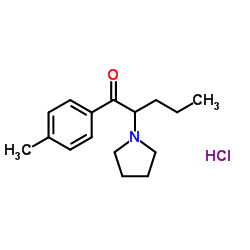Pyrovalerone hydrochloride solution

Pyrovalerone hydrochloride solution structure
|
Common Name | Pyrovalerone hydrochloride solution | ||
|---|---|---|---|---|
| CAS Number | 1147-62-2 | Molecular Weight | 281.821 | |
| Density | N/A | Boiling Point | 362.4ºC at 760mmHg | |
| Molecular Formula | C16H24ClNO | Melting Point | 171-174°C | |
| MSDS | Chinese USA | Flash Point | 127.3ºC | |
| Symbol |



GHS05, GHS07, GHS09 |
Signal Word | Danger | |
| Name | Pyrovalerone hydrochloride solution |
|---|---|
| Synonym | More Synonyms |
| Boiling Point | 362.4ºC at 760mmHg |
|---|---|
| Melting Point | 171-174°C |
| Molecular Formula | C16H24ClNO |
| Molecular Weight | 281.821 |
| Flash Point | 127.3ºC |
| Exact Mass | 281.154633 |
| PSA | 20.31000 |
| LogP | 4.18210 |
| Vapour Pressure | 1.93E-05mmHg at 25°C |
| Storage condition | Controlled Substance, -20°C Freezer, Under Inert Atmosphere |
CHEMICAL IDENTIFICATION
HEALTH HAZARD DATAACUTE TOXICITY DATA
|
| Symbol |



GHS05, GHS07, GHS09 |
|---|---|
| Signal Word | Danger |
| Hazard Statements | H302-H318-H411 |
| Precautionary Statements | P273-P280-P305 + P351 + P338 |
| Hazard Codes | Xn,T,F |
| Risk Phrases | 22-41-52-39/23/24/25-23/24/25-11 |
| Safety Phrases | 26-39-45-36/37-16-7 |
| RIDADR | UN1230 - class 3 - PG 2 - Methanol, solution |
| RTECS | YV9100000 |
| HS Code | 2933910022 |
| HS Code | 2933910022 |
|---|
|
[Issues on the use of ethnobotanicals].
Rev. Med. Chir. Soc. Med. Nat. Iasi. 115(4) , 1069-72, (2011) To identify the risk factors for the use of ethnobotanicals and the people at risk to becoming users.This questionnaire basez objective population study included 89 subjects aged 14 to 42 years.19.10%... |
|
|
1-(4-Methylphenyl)-2-pyrrolidin-1-yl-pentan-1-one (Pyrovalerone) analogues: a promising class of monoamine uptake inhibitors.
J. Med. Chem. 49(4) , 1420-32, (2006) Dopamine, serotonin, and norepinephrine are essential for neurotransmission in the mammalian system. These three neurotransmitters have been the focus of considerable research because the modulation o... |
|
|
Toxicological determination and in vitro metabolism of the designer drug methylenedioxypyrovalerone (MDPV) by gas chromatography/mass spectrometry and liquid chromatography/quadrupole time-of-flight mass spectrometry.
Rapid Commun. Mass Spectrom. 24(18) , 2706-14, (2010) A method for the toxicological screening of the new designer drug methylenedioxypyrovalerone (MDPV) is described; with an emphasis on its application for anti-doping analysis. The metabolism of MDPV w... |
| 1-(4-methylphenyl)-2-pyrrolidin-1-ylpentan-1-one,hydrochloride |
| EINECS 214-556-9 |
| 1-(4-Methylphenyl)-2-(1-pyrrolidinyl)-1-pentanone hydrochloride (1:1) |
| 1-Pentanone, 1-(4-methylphenyl)-2-(1-pyrrolidinyl)-, hydrochloride (1:1) |
| Pyrovalerone hydrochloride |